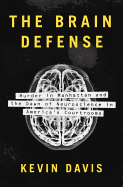
To some, the increasing role of neuroscience in the courtroom is the modern equivalent of 1970s comedian Flip Wilson's plea of innocence: "The devil made me do it." However, as Kevin Davis shows in The Brain Defense, technological advances in the scanning of brain activity are providing defense attorneys with ever more sophisticated tools to build a case. A former crime reporter and professor of journalism and writing, Davis (Defending the Damned) builds his study from one of the first instances where a brain scan entered the courtroom--the lurid case of Herbert Weinstein, who in 1991 confessed to strangling his wife and throwing her body out the 12th-story window of his Upper East Side apartment. An MRI of Weinstein's brain showed a cyst "the size of an orange" over his temporal lobe, or, according to one specialist who evaluated the scan: "he is not rowing with all his oars in the water."
It would be easy for a subject as steeped in scientific jargon and legalese as "neurolaw" to lead to a big yawn, but Davis smoothly guides his narrative through the quagmire of acronyms and precedents with arresting participant interviews. He demonstrates that "broken brains" apply not just to violent criminal behavior, but also to the "abnormal" acts of athletes who play contact sports, juveniles, addicts and military veterans. The Brain Defense concludes that the role of neuroscience in the courtroom is still evolving. Its most prevalent application today is not in establishing guilt but in mitigating death penalty judgments. As one attorney active in the field summarizes: "The real issue is what the hell do we do with people when it comes to sentencing." --Bruce Jacobs, founding partner, Watermark Books & Cafe, Wichita, Kan.

